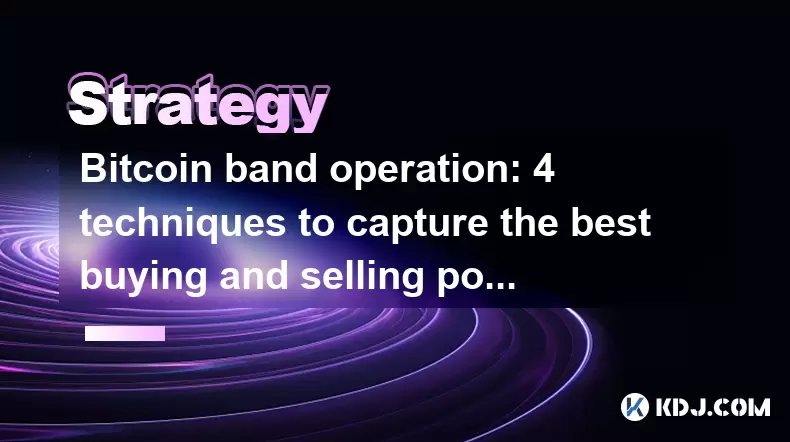-
 bitcoin
bitcoin $124586.364639 USD
0.62% -
 ethereum
ethereum $4670.671710 USD
3.33% -
 xrp
xrp $2.983701 USD
0.18% -
 tether
tether $1.000175 USD
-0.03% -
 bnb
bnb $1209.430642 USD
2.76% -
 solana
solana $231.365861 USD
0.51% -
 usd-coin
usd-coin $0.999665 USD
-0.02% -
 dogecoin
dogecoin $0.264657 USD
4.46% -
 tron
tron $0.346415 USD
1.60% -
 cardano
cardano $0.871586 USD
3.70% -
 chainlink
chainlink $23.451270 USD
7.56% -
 hyperliquid
hyperliquid $46.860071 USD
-2.96% -
 ethena-usde
ethena-usde $1.000120 USD
0.04% -
 sui
sui $3.611279 USD
1.08% -
 stellar
stellar $0.407149 USD
0.96%
Bitcoin band operation: 4 techniques to capture the best buying and selling points
Bitcoin band operations use Bollinger Bands, Keltner Channels, Donchian Channels, and Moving Average Envelopes to identify optimal buying and selling points in the crypto market.
May 25, 2025 at 10:49 am

Bitcoin band operation is a popular trading strategy used by many in the cryptocurrency market to identify optimal buying and selling points. This strategy involves using different technical indicators to create bands or channels around the price action of Bitcoin. These bands help traders determine when to enter or exit the market based on the price's position relative to the bands. In this article, we will explore four key techniques that traders can use to capture the best buying and selling points using Bitcoin band operations.
Bollinger Bands
Bollinger Bands are one of the most widely used tools in technical analysis for Bitcoin trading. These bands consist of a middle band, typically a simple moving average (SMA), and two outer bands that are standard deviations away from the middle band. The key to using Bollinger Bands effectively is to understand how the price interacts with these bands.
- Identify the Bands: Start by plotting the Bollinger Bands on your Bitcoin chart. The default settings are usually a 20-day SMA for the middle band and two standard deviations for the upper and lower bands.
- Watch for Price Touches: When the price of Bitcoin touches or crosses the upper band, it might be overbought, suggesting a potential selling point. Conversely, if the price touches or crosses the lower band, it might be oversold, indicating a potential buying opportunity.
- Look for Band Squeezes: A band squeeze occurs when the bands come closer together, indicating low volatility. A subsequent expansion of the bands can signal the start of a new trend, providing a potential entry point.
Keltner Channels
Keltner Channels are another effective tool for Bitcoin band operations. Similar to Bollinger Bands, Keltner Channels consist of a middle line and two outer bands. However, the middle line is typically an exponential moving average (EMA), and the outer bands are based on the average true range (ATR).
- Set Up the Channels: Plot the Keltner Channels on your Bitcoin chart. The default settings are often a 20-day EMA for the middle line and the ATR multiplied by a factor (usually 2) for the outer bands.
- Monitor Price Action: When the price of Bitcoin moves above the upper channel, it may be overbought, indicating a potential sell signal. If the price falls below the lower channel, it might be oversold, suggesting a potential buy signal.
- Watch for Breakouts: A breakout from the upper or lower channel can signal the start of a new trend. Traders can use these breakouts to enter trades in the direction of the breakout.
Donchian Channels
Donchian Channels are a simple yet powerful tool for identifying potential trading opportunities in Bitcoin. These channels are formed by plotting the highest high and the lowest low over a specified period.
- Plot the Channels: Set up the Donchian Channels on your Bitcoin chart. The default period is often 20 days, but this can be adjusted based on your trading strategy.
- Identify Breakouts: When the price of Bitcoin breaks above the upper channel, it signals a potential buying opportunity. Conversely, a break below the lower channel indicates a potential selling point.
- Use as Support and Resistance: The upper and lower channels can also serve as dynamic levels of support and resistance. Traders can use these levels to gauge potential reversal points.
Moving Average Envelopes
Moving Average Envelopes are another technique for Bitcoin band operations that involve plotting bands around a moving average. These bands are typically set at a fixed percentage above and below the moving average.
- Set Up the Envelopes: Plot the Moving Average Envelopes on your Bitcoin chart. The default settings are often a 20-day SMA with bands set at 5% above and below the SMA.
- Identify Overbought and Oversold Levels: When the price of Bitcoin moves above the upper envelope, it may be overbought, suggesting a potential selling point. If the price falls below the lower envelope, it might be oversold, indicating a potential buying opportunity.
- Watch for Price Reversals: Traders can use the envelopes to identify potential reversal points. When the price approaches the upper or lower envelope, it may signal an impending reversal.
Combining Techniques
While each of these techniques can be effective on its own, combining them can provide a more robust trading strategy. For example, traders can use Bollinger Bands to identify overbought and oversold levels and Keltner Channels to confirm potential breakouts. Similarly, Donchian Channels can be used to identify breakouts, while Moving Average Envelopes can help confirm potential reversal points.
- Use Multiple Indicators: Plot multiple indicators on your Bitcoin chart to gain a comprehensive view of the market.
- Confirm Signals: Look for confluence between different indicators to increase the reliability of your trading signals.
- Adjust Settings: Experiment with different settings for each indicator to find the combination that works best for your trading style.
Practical Application
To apply these techniques effectively, traders need to practice and refine their strategies. Here’s a step-by-step guide on how to implement these techniques in a real trading scenario:
- Choose Your Platform: Select a reliable trading platform that supports the plotting of technical indicators such as Bollinger Bands, Keltner Channels, Donchian Channels, and Moving Average Envelopes.
- Set Up Indicators: Plot the desired indicators on your Bitcoin chart using the settings mentioned above.
- Monitor the Market: Keep an eye on the price action and how it interacts with the bands and channels.
- Identify Opportunities: Look for potential buying and selling opportunities based on the signals provided by the indicators.
- Execute Trades: Enter or exit trades based on the signals, ensuring to use proper risk management techniques such as stop-loss orders.
Frequently Asked Questions
Q1: Can these techniques be used for other cryptocurrencies besides Bitcoin?Yes, these techniques can be applied to other cryptocurrencies. The principles of technical analysis remain the same, although the volatility and market dynamics may differ.
Q2: How often should I adjust the settings of these indicators?The frequency of adjusting the settings depends on your trading style and the market conditions. Some traders may find it beneficial to adjust settings periodically, while others may prefer to stick with a consistent setup.
Q3: Are these techniques suitable for beginners?While these techniques can be used by beginners, it is important for new traders to thoroughly understand each indicator and practice in a demo account before using them in live trading.
Q4: Can these techniques be automated?Yes, these techniques can be automated using trading algorithms and bots. However, it is crucial to backtest and monitor the performance of any automated system to ensure its effectiveness.
Disclaimer:info@kdj.com
The information provided is not trading advice. kdj.com does not assume any responsibility for any investments made based on the information provided in this article. Cryptocurrencies are highly volatile and it is highly recommended that you invest with caution after thorough research!
If you believe that the content used on this website infringes your copyright, please contact us immediately (info@kdj.com) and we will delete it promptly.
- BlockDAG, DOGE, HYPE Sponsorship: Crypto Trends Shaping 2025
- 2025-10-01 00:25:13
- Deutsche Börse and Circle: A StableCoin Adoption Powerhouse in Europe
- 2025-10-01 00:25:13
- BlockDAG's Presale Buzz: Is It the Crypto to Watch in October 2025?
- 2025-10-01 00:30:13
- Bitcoin, Crypto, and IQ: When Genius Meets Digital Gold?
- 2025-10-01 00:30:13
- Stablecoins, American Innovation, and Wallet Tokens: The Next Frontier
- 2025-10-01 00:35:12
- NBU, Coins, and Crypto in Ukraine: A New Yorker's Take
- 2025-10-01 00:45:14
Related knowledge

Practical parameter settings for a Bitcoin multi-timeframe moving average system
Sep 18,2025 at 10:54pm
Optimizing Timeframe Combinations for Bitcoin Trading1. Selecting appropriate timeframes is crucial when building a multi-timeframe moving average sys...

How can I filter out false breakouts in Dogecoin high-frequency trading?
Sep 22,2025 at 01:00am
Understanding False Breakouts in Dogecoin Trading1. A false breakout occurs when Dogecoin's price appears to move beyond a defined support or resistan...

Techniques for identifying tops and bottoms in the Bitcoin on-chain NVT model
Sep 20,2025 at 07:54pm
Understanding the NVT Model in Bitcoin Analysis1. The Network Value to Transactions (NVT) ratio is often described as the 'P/E ratio' of the cryptocur...

What does the surge in open interest in Bitcoincoin futures mean?
Sep 20,2025 at 11:18pm
Understanding the Surge in Dogecoin Futures Open Interest1. A surge in open interest within Dogecoin futures indicates a growing number of active cont...

How can I use the Ethereum USDT premium to gauge market sentiment?
Sep 18,2025 at 11:55pm
Understanding the Ethereum USDT Premium1. The Ethereum USDT premium refers to the price difference between USDT (Tether) traded on Ethereum-based plat...

What should I do if Ethereum staking yields decline?
Sep 20,2025 at 06:18am
Understanding the Causes Behind Declining Ethereum Staking Yields1. The Ethereum network transitioned to a proof-of-stake consensus mechanism with the...

Practical parameter settings for a Bitcoin multi-timeframe moving average system
Sep 18,2025 at 10:54pm
Optimizing Timeframe Combinations for Bitcoin Trading1. Selecting appropriate timeframes is crucial when building a multi-timeframe moving average sys...

How can I filter out false breakouts in Dogecoin high-frequency trading?
Sep 22,2025 at 01:00am
Understanding False Breakouts in Dogecoin Trading1. A false breakout occurs when Dogecoin's price appears to move beyond a defined support or resistan...

Techniques for identifying tops and bottoms in the Bitcoin on-chain NVT model
Sep 20,2025 at 07:54pm
Understanding the NVT Model in Bitcoin Analysis1. The Network Value to Transactions (NVT) ratio is often described as the 'P/E ratio' of the cryptocur...

What does the surge in open interest in Bitcoincoin futures mean?
Sep 20,2025 at 11:18pm
Understanding the Surge in Dogecoin Futures Open Interest1. A surge in open interest within Dogecoin futures indicates a growing number of active cont...

How can I use the Ethereum USDT premium to gauge market sentiment?
Sep 18,2025 at 11:55pm
Understanding the Ethereum USDT Premium1. The Ethereum USDT premium refers to the price difference between USDT (Tether) traded on Ethereum-based plat...

What should I do if Ethereum staking yields decline?
Sep 20,2025 at 06:18am
Understanding the Causes Behind Declining Ethereum Staking Yields1. The Ethereum network transitioned to a proof-of-stake consensus mechanism with the...
See all articles










































































